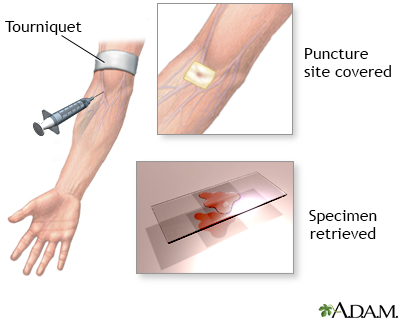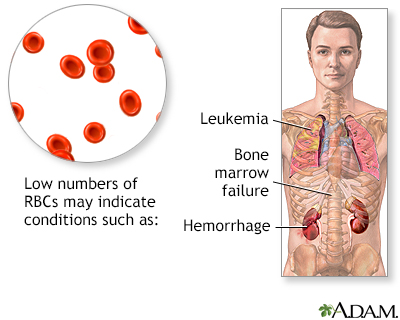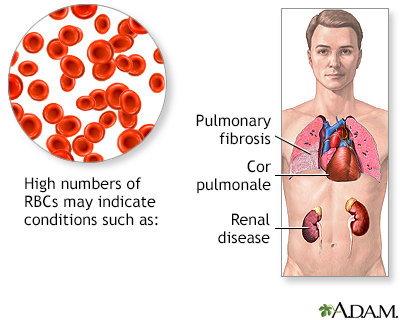Health exams for: #AGEGROUP#
The following exams, tests, and procedures are recommended for #AGEGROUPLOWER#.#FEMALETEXT#
Select a link from the list below to learn how and why each test is performed, as well how to prepare for it.

The following exams, tests, and procedures are recommended for #AGEGROUPLOWER#.#FEMALETEXT#
Select a link from the list below to learn how and why each test is performed, as well how to prepare for it.




The complete blood count (CBC) is test, used to diagnose and monitor numerous diseases. It can reflect problems with fluid volume (such as dehydration) or loss of blood. It can show abnormalities in the production, life span, and destruction of blood cells. It can reflect acute or chronic infection, allergies, and problems with clotting. The CBC test identifies and counts the 7 types of cells found in the blood, red blood cell, neutrophil, eosinophil, basophil, lymphocyte, monocyte, and platelet.
The complete blood count (CBC) is test, used to diagnose and monitor numerous diseases. It can reflect problems with fluid volume (such as dehydratio...
A CBC requires a small blood specimen. Blood is drawn from a vein, usually from the inside of the elbow or the back of the hand. To prepare, the skin should be cleaned with alcohol or iodine before the test. The patient should be seated comfortably or reclining. When the needle is inserted to draw blood, some people feel moderate pain, while others feel only a prick or stinging sensation. After the blood is drawn, there may be some throbbing. Although the CBC test is very safe, any blood drawing has a slight risk of complication, including oozing of blood from puncture site; fainting or feeling lightheaded; hematoma (blood accumulating under the skin); multiple punctures to locate veins; or infection (a slight risk any time the skin is broken).
A CBC requires a small blood specimen. Blood is drawn from a vein, usually from the inside of the elbow or the back of the hand. To prepare, the skin...
Results; Normal values vary with altitude and sex. What abnormal results may mean; Low numbers of red blood cells may indicate blood loss; anemia (various types); hemorrhage; bone marrow failure (for example, from radiation, toxin, fibrosis, tumor); erythropoietin deficiency (secondary to renal disease); hemolysis (RBC destruction) from transfusion reaction; leukemia; multiple myeloma; malnutrition (nutritional deficiencies of iron, folate, vitamin B12, vitamin B6); or over hydration. Low numbers of white blood cells (leukopenia) may indicate bone marrow failure (for example, due to granuloma (granular tumor), tumor, or fibrosis); presence of cytotoxic substance; collagen-vascular diseases (such as lupus erythematosus); disease of the liver or spleen; or radiation exposure. High numbers of white blood cells (leukocytosis) may indicate infectious diseases; inflammatory disease (such as rheumatoid arthritis or allergy); leukemia; severe emotional or physical stress; or tissue damage (for example, burns). A low hematocrit may indicate anemia (various types); blood loss (hemorrhage); bone marrow failure (for example, due to radiation, toxin, fibrosis, tumor); hemolysis (RBC destruction) related to transfusion reaction; leukemia; malnutrition or specific nutritional deficiency; multiple myeloma; over hydration; or rheumatoid arthritis. A high hematocrit may indicate dehydration; burns; diarrhea; eclampsia; erythrocytosis; polycythemia vera; or shock. Low hemoglobin values may indicate anemia (various types) or blood loss.
Results; Normal values vary with altitude and sex. What abnormal results may mean; Low numbers of red blood cells may indicate blood loss; anemia (va...
High numbers of red blood cells may indicate cigarette smoking; low oxygen tension in the blood; congenital heart disease; cor pulmonale; pulmonary fibrosis; polycythemia vera; dehydration (such as from severe diarrhea); or emphysema.
High numbers of red blood cells may indicate cigarette smoking; low oxygen tension in the blood; congenital heart disease; cor pulmonale; pulmonary f...
Review Date: 10/16/2022
Reviewed By: Mark Levin, MD, Hematologist and Oncologist, Monsey, NY. Review provided by VeriMed Healthcare Network. Also reviewed by David C. Dugdale, MD, Medical Director, Brenda Conaway, Editorial Director, and the A.D.A.M. Editorial team.



